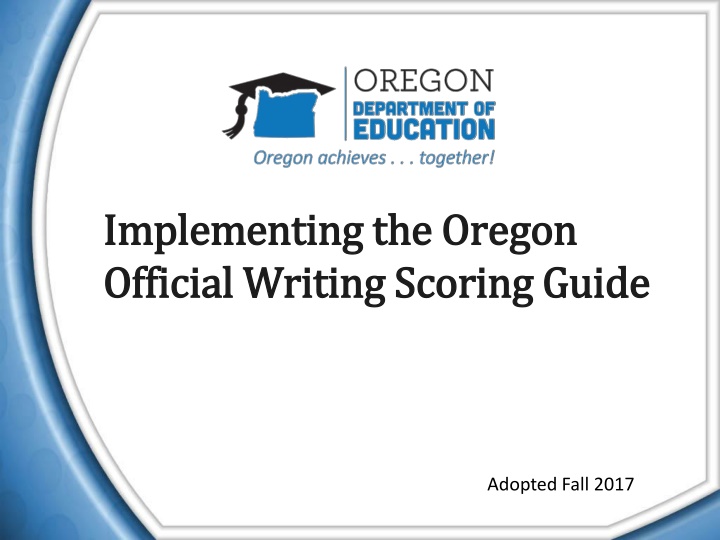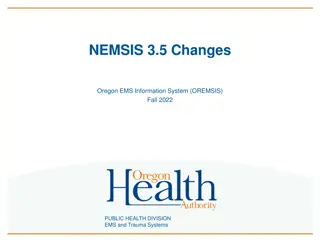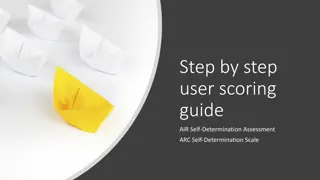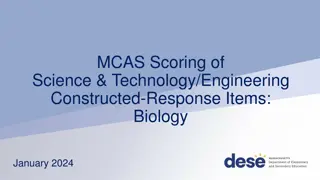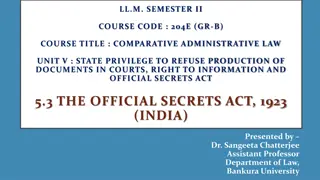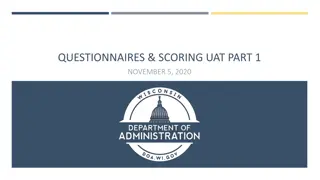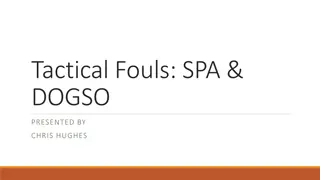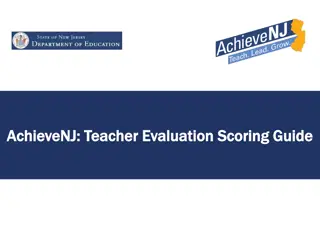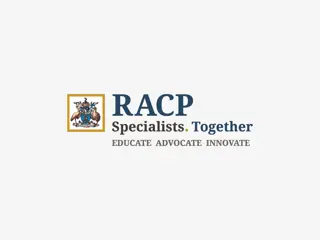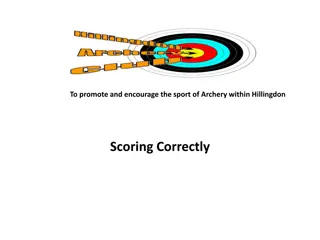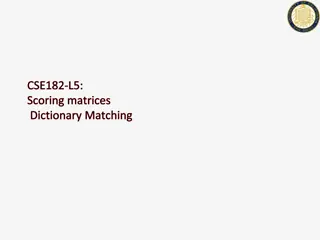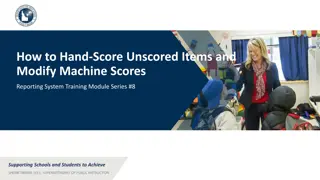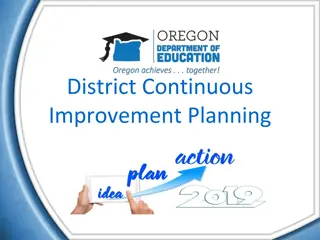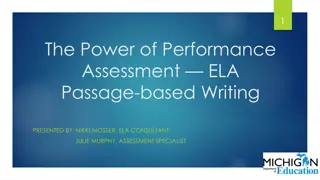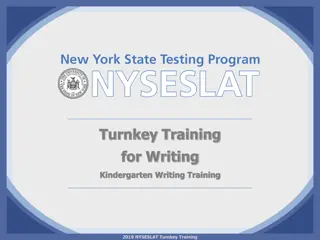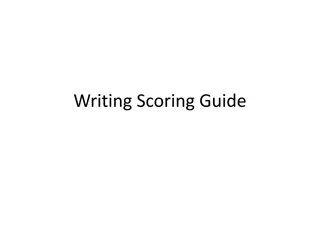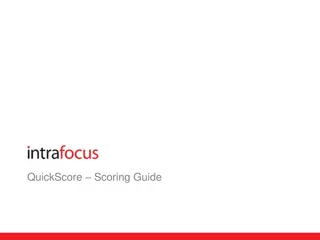Implementing the Oregon Official Writing Scoring Guide
The implementation of the Oregon Official Writing Scoring Guide, adopted in Fall 2017, underwent a revision process driven by the adoption of Common Core State Standards. The historical timeline, revision process, and resources for implementing the updated scoring guide are detailed, emphasizing the transition from legacy to official scoring guides. Key changes, including the alignment with CCSS and transition to Smarter Balanced ELA Assessments, are highlighted.
Download Presentation

Please find below an Image/Link to download the presentation.
The content on the website is provided AS IS for your information and personal use only. It may not be sold, licensed, or shared on other websites without obtaining consent from the author.If you encounter any issues during the download, it is possible that the publisher has removed the file from their server.
You are allowed to download the files provided on this website for personal or commercial use, subject to the condition that they are used lawfully. All files are the property of their respective owners.
The content on the website is provided AS IS for your information and personal use only. It may not be sold, licensed, or shared on other websites without obtaining consent from the author.
E N D
Presentation Transcript
Implementing the Oregon Implementing the Oregon Official Writing Scoring Guide Official Writing Scoring Guide Adopted Fall 2017
Agenda Definitions and Implementation Historical Timeline Definitions and Implementation Historical Timeline Background: History of Official Scoring Guide Background: History of Official Scoring Guide Why was there a revision? What was the revision process? How was the Scoring Guide tested ? Official and Legacy Scoring Guides Official and Legacy Scoring Guides What has remained the same? What has changed? Resources on Implementing Official Scoring Guide Resources on Implementing Official Scoring Guide
Writing Scoring Guides Descriptors & Definitions Official Writing Scoring Guides refers to the updated scoring guides for implementation beginning Fall 2017. Legacy Writing Scoring Guides refers to the previous writing scoring guides, which are not aligned the CCSS and are no longer approved.
What is the Implementation Historical Timeline? 2016-2017 either Official Writing Scoring Guide or Legacy Official Writing Scoring Guide were permitted for scoring Essential Skills Work Samples. 2017-2018 The updated Official Writing Scoring Guide becomes the Official State Scoring Guide for all grades; Legacy Official Writing Scoring Guide sunsets .
Why the Revision? Adoption of the Common Core State Standards in October of 2010; with implementation in 2013- 2014 dictated an alignment review of assessment tools used to measure instructional standards. Smarter Balanced ELA Assessments represent a new approach to writing assessment with a new vocabulary. Writing Scoring Guide retained as tool for Essential Skills Assessment and Local Performance Assessments.
What was the Revision Process? A panel of educators met for two days in Spring of 2014: teachers, TOSAs, ESD representatives, and writing scoring directors. Review materials included Common Core Standards for Writing, Education Northwest Rubrics, Smarter Balanced Rubrics.
What was the Revision Process? Panelists identified key language and skills in the CCSS, and composed a list of recommendations specifying changes to the guide that would not affect rigor. Draft versions were distributed to the panelists for feedback and piloting in fall and winter, 2014-2015. After additional edits were made to address feedback from the pilot, draft versions of the scoring guide, developed by an outside contractor, were posted for statewide review and use in spring, 2015.
How was the Scoring Guide Tested? Panels were established at two separate sites; both sites scored the same set of field test papers. Panelists received an overview of the differences in the new official scoring guide vs. the legacy scoring guide. Panels were trained by the same trainer using the same training materials and anchor papers.
Data Comparison of Writing Scoring Guides 6.00 5.00 Mean Trait Score 4.00 3.00 2.00 1.00 0.00 I / C 3.57 3.57 Org. 3.50 3.54 Sent. Fl. 3.72 3.63 Conv. 3.56 3.58 Legacy SG Official SG
Scoring Impact The use of the updated scoring guide does not reflect an expectation of greater rigor in the Ideas and Content, Organization, Sentence Fluency, and Conventions at the 4 score point, just stronger alignment to Common Core language. The other scoring guide traits and levels were not evaluated in terms of increases in rigor, but our estimation is that rigor did increase at least in Use of Sources.
What has remained the same? 6-point scaled rubric. Four counting traits remain the same: Ideas and Content, Organization, Sentence Fluency, and Conventions. A score of 4 meets the standard , exception 3rdgrade. (Essential Skills and Local Performance Assessment Manual Guidelines). Remains the sole instrument approved by the State Board for scoring Essential Skills writing samples.
Official Scoring Guide Grades 3rd 8th The requirement to collect a Local Performance Assessment in writing at grades 3-8 (and once in high school) remains. The Local Performance Assessment requirement can be fulfilled through work sample prompts scored using the Official Writing Scoring Guide or other comparable measures adopted by the district. For additional information, please see the Local Performance Assessment webpage.
What about Essential Skills? Work Samples are still one way students can demonstrate proficiency in writing for Essential Skills. Students produce two passing samples; one must be either Explanatory or Argumentative. Minimum score of 4 in Ideas, Organization, Sentence Fluency, Conventions. Revision is an allowable option.
Important Notes to Remember Feedback may only be provided after the Work Sample has been completed and scored. The official scoring guides and accompanying scoring forms are the only means that districts may use to communicate feedback. Papers scored prior to 2017 2018 using the Legacy Scoring Guide do NOT need to be re-scored using the Official Writing Scoring Guide. Writing based on source material is not required but is desirable to help ensure students are college and career ready.
What is slightly different? Oregon Modes align with Common Core Text Types & Purposes Persuasive Opinion / Argumentative Expository Informative/Explanatory Narrative Narrative, real or imagine
6 Traits Comparison Narrative Scoring Guide Informative Scoring Guide * Ideas and Content * Organization * Sentence Fluency * Conventions Voice Word Choice * Ideas and Content * Organization * Sentence Fluency * Conventions Voice Word Choice Use of Sources
What has Changed? The Official Writing Scoring Guide includes two separate but correlated rubrics. Narrative Writing Explanatory/Argumentative Writing Shifts in CCSS language occur primarily in the trait areas of Ideas and Content and Organization. The changes are primarily seen in the higher achievement levels of 5 or 6. Trait 7: Citing Sources has become Use of Sources .
What are Changes in Scoring Guide Traits? Ideas and Content Insertion of the word claims . In argumentative writing that counterclaims will be acknowledged. More verbiage surrounding the use of details beyond relevance. Use of resources addressed more extensively.
What are Changes in Scoring Guide Traits? Organization Specific references to claims or arguments . Conclusion supports the argument, claims, information or explanation presented; follows a logical progression. Details support the arguments, information, or explanations used. Connections to source materials, where used, are integrated into the writing.
What are Changes in Scoring Guide Traits? Voice In the bold: an objective tone and level of formality consistent with norms in the discipline. Same reference to objective tone and level of formality is repeated in bullets.
What are Changes in Scoring Guide Traits? Word Choice Domain-specific vocabulary is referenced at each score point. Academic language is used accurately to convey information or make claims/counterclaims, arguments or explanations. At the 5 and 6 levels, language is used accurately to convey information and clarify relationships among information, claims/counterclaims, reasons and evidence.
What are Changes in Scoring Guide Traits? Sentence Fluency At the high school level, Sentence Fluency is not explicitly addressed in the Common Core. In the Smarter Balanced rubric, reference is made to syntactic control is strong. This phrase is used at the 6 level.
What are Changes in Scoring Guide Traits? Conventions No changes were made Grade level expectations for Conventions are explicitly stated in the Common Core
Informative / Explanatory & Argumentative Use of Sources Is there evidence multiple sources were consulted to support the arguments? Are there attributions present to acknowledge the source material? How effectively was source material integrated into the paper? Was the student successful at avoiding plagiarism by paraphrasing or using quotation marks?
Implementing Resources ODE Scoring Guides http://www.oregon.gov/ode/educator-resources/essentialskills/Pages/Scoring-Guides.aspx Scoring Guide Highlighted Differences Narrative: http://www.oregon.gov/ode/educator-resources/assessment/Documents/writing- scoring-guide_narrative_highlighted.pdf Informative / Explanatory & Argumentative: http://www.oregon.gov/ode/educator-resources/assessment/Documents/writing- scoring-guide_explan-arg_highlighted.pdf ODE Essential Skills Writing Work Samples Website http://www.oregon.gov/ode/educator-resources/essentialskills/Pages/Writing-Work- Sample-Tasks.aspx ODE Local Performance Assessment Website http://www.oregon.gov/ode/educator-resources/assessment/Pages/Local-Performance- Assessment-Requirement.aspx
Implementing Resources Essential Skills and Local Performance Assessment Manual http://www.oregon.gov/ode/educator- resources/essentialskills/Documents/es_localperformanceasmt_man ual.pdf State Board Meeting June 2016 Presentation analysis of updated Official Writing Scoring Guide http://www.oregon.gov/ode/about-us/stateboard/Pages/State- Board-Meeting06232016.aspx
